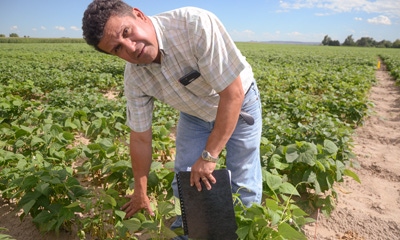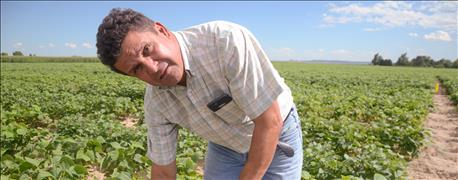
In Carlos Urrea's office is a box full of envelopes — about 140 envelopes, to be exact. But this isn't your typical office. Each of those envelopes contains one individual dry edible bean F1 cross — the first generation of several throughout the bean-breeding process.

TESTING NEW VARIETIES: Carlos Urrea inspects dry edible beans in one of his plots at the Panhandle REC. In this plot, Urrea is testing the drought tolerance of dry edible beans, by not irrigating them from flowering onward. In this trial, which involves using weather stations and Watermark sensors, he is identifying drought-susceptible varieties, which he explains use up the top 9 inches of soil moisture more quickly than those that are more drought-tolerant.
Urrea, associate professor and dry edible bean breeding specialist at the University of Nebraska Panhandle Research and Extension Center in Scottsbluff, is one of a small handful of public breeders of dry edible beans in the U.S. In the 11 years he's been at the Panhandle REC, Urrea has worked with all market classes of dry edible beans — including pintos, Great Northerns, cranberry beans, red kidney beans, black beans, navy beans and garbanzos.
In those 11 years, with changing management practices and the challenging growing environments producers in Nebraska and around the world are facing, along with the changing habits of consumers, he has been focusing on some new frontiers.
One of Urrea's major focuses is selecting beans for resistance to multiple diseases like common rust, white mold, root rot and bacterial blight — in addition to higher yields, the driving factor behind whether or not growers plant a variety. As he points out, "If I tell growers 'this variety yields 1,000 pounds per acre but has a good disease package, and this one yields 3,000 pounds per acre but is susceptible to disease,' they'll pick the susceptible variety every time."
Making headway in bean breeding
As more growers in Nebraska move from traditional to direct harvest of dry edible beans, Urrea is selecting beans for upright plant architecture, stronger stems, standability and high pod position above the ground — a must for growers who are harvesting beans from the field in one pass, instead of cutting, windrowing and then harvesting.
Drought and heat tolerance are another focus. Although most of the dry bean acres in Nebraska are irrigated, Urrea notes with more allocations on water use every year, it's advantageous for growers to use less water during some years and use more water for more water-intensive crops in the rotation.
"We are trying to understand the mechanisms of drought tolerance and water-use efficiency," he says. "We're looking at root architecture, but we're finding that deeper roots don't necessarily equate to better water-use efficiency. We're finding drought-tolerant plants have less root rot issues. That tells me there's a connection between root health and drought tolerance, although it's not a 100% correlation."
But it isn't just about developing dry beans that are optimal for growers. Urrea is also working on developing dry bean varieties for the end user — the consumer. This includes working with the Food Science Department at UNL to research the nutritional value in the crop — more specifically, identifying cultivars that are higher in iron and zinc content, and those with high levels of antioxidants, and crossing them with his beans.
One of Urrea's latest accolades is identifying pinto beans and cranberry beans that darken more slowly, meaning a longer shelf life. "People are looking for fresh beans after harvest. Pinto and cranberry beans can get dark pretty quickly," he says. "If you have a bean that takes longer to darken, that means a longer shelf life, and it makes it easier for growers to keep beans in storage and sell when prices get higher, and facilitates the export market."
Bringing new varieties to market
How does the breeding process work? It starts with those F1 crosses in Urrea's office. They're planted at a research plot on the Panhandle REC. After trials throughout the growing season to select for traits like upright plant architecture, disease resistance, yield and water-use efficiency, seeds from plants that make the grade are harvested and sent to Puerto Rico, where they can be grown year-round.
This way, the breeding process is faster, and new cultivars can be brought to the market earlier. "This way I'm advancing one generation to another a lot faster," Urrea says. "When I bring them back to the U.S., I continue the yield trials, and it keeps going," selecting for the traits listed above.
The process continues, with beans going to Puerto Rico over winter and coming back to be tested in Nebraska for three or four more years. The resulting elite lines are compared with commercial cultivars in research plots in "mother" trials at the research center and in Nebraska growers' fields in "baby" trials — a process Urrea brought to Nebraska from his days as a corn breeder with the International Maize and Wheat Improvement Center, based in Mexico.
But the breeding process doesn't just benefit growers domestically. Several times a year, Urrea visits countries in Africa and South America to select varieties and test for drought tolerance and resistance to different bacterium and fungal pathogens. While visiting the International Center for Tropical Agriculture in Colombia, he identified black beans and red beans with a high iron content as well as drought and heat tolerance. In Zambia and Uganda, he identified several black, red and cannellini beans with tolerance to drought and common bacterial blight.
"I'm using these beans to help growers in different parts of the world. If I find a bean with disease resistance in Africa, not only can I bring the variety home and incorporate it into our program, but growers in Africa also benefit from having that disease resistance," Urrea says. "The goal is to develop beans not only for Nebraska, but for international locations."
About the Author(s)
You May Also Like






